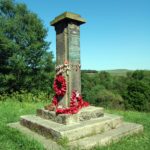Debris from Oxford LX518 (and a pair of air crash site researchers)
‹ Return to Air Crash Sites

Debris from Oxford LX518 (and a pair of air crash site researchers)
18 October 1943. 22 year old New Zealander Denis Patrick Kyne was a Pilot Officer with the RAF. He was undertaking a solo training flight at night to learn how to handle a twin engined aircraft.
The excercise was a short triangular route around the Telford area; from RAF Wheaton Aston near Stafford, south west to near Shrewsbury, then a north eastern leg to Shawbury before the final turn back to base.
Pilot Officer Kyne would have made his turns on seeing the beacons at these pre-designated spots. However, the beacon at Shawbury wasn’t in use and at the same time the weather took a turn for the worse.
It is not known why the lost P/O Kyne didn’t try to resolve the problem using communication aids.
Instead he continued at the same altitude and on the same heading until his Oxford crashed on the high moors of the Dark Peak, over 50 miles from his last turn point. Probably he panicked a bit and rather than do anything to his controls, just maintained the same heading hoping he’d see something in the blacked out Britain beneath him.
The wreck was discovered 4 days later by grouse beaters. Pilot Officer Kyne was from Timaru, Canterbury, south of Christchurch.
Details from High Peak Air Crash Sites (2010) by Pat Cunningham (pictured above with Sean of Peak Wreck Hunters)
16 comments on “Debris from Oxford LX518 (and a pair of air crash site researchers)”
Leave a Reply Cancel reply
Image Information
-
Full Size: 1112×668px
Aperture: f/8
Focal Length: 22mm
ISO: 200
Shutter: 1/60 sec
Camera: NIKON D40



Four days undiscovered ! That really is something.
Amazing history of this crash Ian and brilliant photographicshots of the area!!!:-)
These are ever increasingly interesting ( it seems to me ) – another well identified and recorded Ian. All you needed was the Spitfire flying overhead 😉 £400 seems a snip but I’m first!
The usual superb documentation Ian . and this time i must have already eaten my pie 🙂
brilliant research ian and great photos
I’m always amazed by seeing these wrecks, how bits of aircraft are still scattered across the ground more than half a century later. What I can’t quite understand is how vegetation hasn’t covered everything. You mention how the salvage crew burnt the wreck on the spot, hence the blackened ground, but you’d think in 68 years all evidence of that would have disappeared.
Well done again mate.
I’m with Phill [http://www.flickr.com/photos/phillwatson]
Amazing stuff once again Ian
I’m always amazed with your shots of these places that there is so much evidence still there. The fact you can still find the impact point after all these years is amazing.
So well done as always Ian…………………..!!!
Janwillem
great work again ian loving the history mate.
and brilliant photo’s as always.
Well done Ian,Neal informed me there is a pilot still buried up in the Cheviots as his plane went head first in to the peaty hillside
Another good one Ian. I saw a documentary last year which briefly mentioned a large scrapyard near Coventry which received and processed aircraft wrecks for recycling. I guess that by late 1943 the priorities were different.
Another good one Ian. What a nightmare for the poor bloke – being stuck up there in the dark not being able to recognise anything down below due to the weather. The thought horrifies me. Strange that no radio communication was received from him.
Another interesting account – great work Ian.